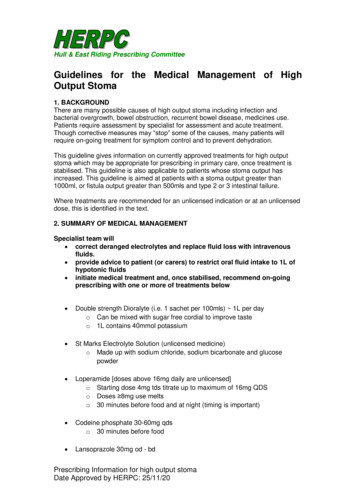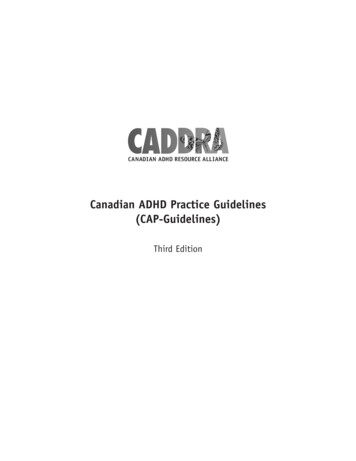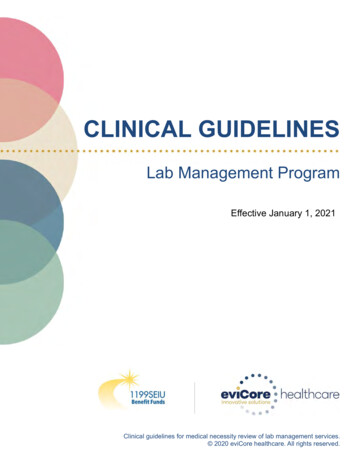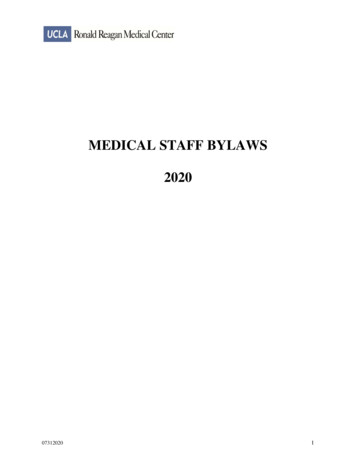
Transcription
Hull & East Riding Prescribing CommitteeGuidelines for the Medical Management of HighOutput Stoma1. BACKGROUNDThere are many possible causes of high output stoma including infection andbacterial overgrowth, bowel obstruction, recurrent bowel disease, medicines use.Patients require assessment by specialist for assessment and acute treatment.Though corrective measures may “stop” some of the causes, many patients willrequire on-going treatment for symptom control and to prevent dehydration.This guideline gives information on currently approved treatments for high outputstoma which may be appropriate for prescribing in primary care, once treatment isstabilised. This guideline is also applicable to patients whose stoma output hasincreased. This guideline is aimed at patients with a stoma output greater than1000ml, or fistula output greater than 500mls and type 2 or 3 intestinal failure.Where treatments are recommended for an unlicensed indication or at an unlicenseddose, this is identified in the text.2. SUMMARY OF MEDICAL MANAGEMENTSpecialist team will correct deranged electrolytes and replace fluid loss with intravenousfluids. provide advice to patient (or carers) to restrict oral fluid intake to 1L ofhypotonic fluids initiate medical treatment and, once stabilised, recommend on-goingprescribing with one or more of treatments below Double strength Dioralyte (i.e. 1 sachet per 100mls) 1L per dayo Can be mixed with sugar free cordial to improve tasteo 1L contains 40mmol potassium St Marks Electrolyte Solution (unlicensed medicine)o Made up with sodium chloride, sodium bicarbonate and glucosepowder Loperamide [doses above 16mg daily are unlicensed]o Starting dose 4mg tds titrate up to maximum of 16mg QDSo Doses 8mg use meltso 30 minutes before food and at night (timing is important) Codeine phosphate 30-60mg qdso 30 minutes before food Lansoprazole 30mg od - bdPrescribing Information for high output stomaDate Approved by HERPC: 25/11/20
oolansoprazole orodispersible tablets or omeprazole dispersible tablets ifabsorption likely to be a problemspecialist may recommend change to famotidine/nizatidine ifhypomagnesaemia is a problem Magnesium supplementationo Magnesium-L-aspartate (Magnaspartate ) 10mmol sachets Dissolve in 50-200mls of water, tea or orange juice One sachet at night, can be increased up to 3 sachets per day(doses above 2 sachets a day are off label)o Monitor for diarrhoea/gastro-intestinal upseto Additional IV magnesium may also be required occasionally tomaintain levels – secondary care only Octreotide (off label)o Specialist may prescribe 50micrograms BD S/C, increased to 100micrograms tds, as trial and stop after 2-3 days if no effecto If effective and required long term – change to long acting preparationsuitable for primary care prescribing as per Shared Care Framework Check trace elements and vitaminso Many patients with high losses have low selenium levels Oral selenium dose 100micrograms three times dailyo Consider Forceval if other trace elements also low Optimise nutrition – provide nutritional supplements as per specialist dietitianadvice3. FURTHER INFORMATION ON INDIVIDUAL TREATMENTSRestrict oral fluid intake and use of Dioralyte double strengthWhen patients drink hypotonic fluids (such as water, tea, coffee, fizzy drinks), are alllow in sodium and draw sodium and fluid into the bowel, causing an increase instoma/fistula output and sodium loss. Restricting oral fluid intake to 1L per day willreduce the stoma output (this can be reduced to 500mls in patients with very highlosses).Hypertonic fluids contain high sodium concentrations (i.e. 90mmol/L), have beenfound to increase absorption of sodium and fluid and therefore help to reduce fluidand electrolyte losses. Double strength Dioralyte (i.e. 2 sachets dissolved in 200mls)is the hypertonic fluid of choice at Hull University Teaching Hospitals NHS Trust.However due to the potassium content it should be used cautiously in patients withrenal impairment and avoided in those with hyperkalaemia.Double strength Dioralyte contains the following:Sodium 120mmol/LPotassium 40mmol/LGlucose 180mmol/LPrescribing Information for high output stomaDate Approved by HERPC: 25/11/20
Patients are advised to drink 1L of double strength Dioralyte per day to help limit fluidloss and maintain sodium levels. To increase palatability a small amount of sugarfree squash can be added to the solution, sipping through a straw may also help. Thesolution can also be made up with a mixture of ice and water or stored in the fridge tohelp improve the taste.For patients with renal impairment, hyperkalaemia, and those unable to tolerateDioralyte, due to the lack of suitable preparations available, St Mark’s Hospital inLondon has produced a unique solution called “St Mark’s Electrolyte Mix”. This is aglucose-electrolyte mix which contains 90mmol/L of sodium and no potassium.If supply issues, the patient could make the solution up fresh every day using thefollowing measurements: 20g (six level 5mL spoonfuls) of Glucose powder2.5g (one heaped 2.5mL spoonful) of Sodium Bicarbonate powder(baking soda) / if the patient cannot tolerate sodium bicarbonate, useSodium Citrate powder3.5g (one level 5mL spoonful) of Sodium Chloride (table salt)This is then dissolved in 1 Litre of tap water, and the patient should drink up to theprescribed volume throughout the day. The solution can be stored at roomtemperature or in the fridge but it must be discarded 24 hours after mixing and afresh solution prepared the next day.Antimotility medicationAntimotility medication reduces intestinal motility and helps to increase absorption offood by slowing gastro-intestinal transit times and is best given 30 minutes beforefood for optimal effect.Loperamide (doses above 16mg daily are off label)Loperamide is the preferred initial choice as it is not sedative or addictive and doesnot cause fat malabsorption. However combined use of loperamide and codeine hasbeen found to have a synergistic effect. Loperamide passes through theenterohepatic circulation, however this is severely disrupted in patient with shortbowel and therefore small bowel transit times may be very rapid. Hence large dosesof loperamide may be required (usually up 16mg four times each day, howeverhigher doses have been used in other centres).Loperamide should initially be started at 4mg four times each day and then graduallytitrated up every 48 hours, with a maximum of 50% dose increase per week. Forindividual doses greater than 8mg, where absorption is a problem or where capsuleshave been discovered unchanged in stoma/fistula output, melts should be usedinstead. There have been reports of cardiac events including QT prolongation,torsades de pointes, and cardiac arrest in patients who have taken high or very highdoses of loperamide as a drug of abuse or for self-treatment of opioid withdrawal.Consider close monitoring if using high doses of loperamide and patient presents aprevious history of cardiac disease.Codeine phosphatePrescribing Information for high output stomaDate Approved by HERPC: 25/11/20
Once a patient is on 8mg QDS of loperamide, codeine should be initiated at a doseof 30-60mg four times each day. A combination of codeine and loperamide is oftenhelpful as they act on different receptors in the bowel. Increasing the dosage ofcodeine beyond 240mg per day has not been associated with an increase in efficacy.Antisecretory medicationAntisecretory medication reduces gastric acid secretion and therefore helps toreduce fluid loss.Lansoprazole / Omeprazole / Famotidine/NizatidineStoma pH levels should be maintained above 6. If the pH is less than 6, lansoprazoleshould be started at a dose of 30mg once daily, this can be increased to 30mg twicedaily if needed. If the stoma pH remains low, despite optimal treatment withlansoprazole, consider switching to lansoprazole orodispersible tablets. If this isunsuccessful, a trial of omeprazole dispersible tablets 40mg twice daily should beconsidered. In patients with very short bowels or where both lansoprazole andomeprazole have been unsuccessful, intravenous pantoprazole 40mg twice dailymay be used.Hypomagnaesemia has been reported in patients treated with proton pump inhibitors,therefore magnesium levels should be monitored regularly. If hypomagnesaemia is aproblem, consider use of either famotidine or nizatidine as an alternative.Trial of octreotide (off label – amber drug)Octreotide may produce a reduction in stoma or fistula output, however the evidenceto support its use is poor. The injections are painful to administer, there is a risk ofdeveloping gallstones and both hypoglycaemia and hyperglycaemia may occur.Octreotide can reduce stoma output by 1-2 L/24 hrs.A trial of 2-3 days of subcutaneous octreotide 50 micrograms twice daily may beworthwhile. Stop treatment after 72 hours if there is no noticeable reduction in output.If improvement is seen, the dose can be titrated gradually up to a maximum of100micrograms three times each day. For long term treatment this can be changedonto a long acting preparation to aid compliance and prescribing may be consideredvia shared care or via homecare route.Magnesium supplementationMagnesium deficiency is common in patients with high output stomas/fistulae due toreduced area of absorption, sodium depletion and hypoaldosterism. Initialreplacement should be given intravenously, however oral magnesiumsupplementation is often required to maintain levels.Magnesium is available orally as Magnesium-L-aspartate 10mmol sachets, 1 sachetup to three times a day. Each sachet should be dissolved in 50-200mls of water, teaor orange juice. Higher oral doses can be used (up to 50mmol per day in divideddoses) however, oral magnesium is associated with gastrointestinal side effects andstoma/fistula output must be monitored carefully.Prescribing Information for high output stomaDate Approved by HERPC: 25/11/20
Trace elements and vitaminsPatients with high losses are also at risk of trace elements and vitamin deficiencies,therefore these should be monitored regularly (see monitoring section for moreinformation). Common deficiencies seen in this group of patients include selenium,zinc and vitamin B.oForceval one capsule once daily is recommended for all patients with a highoutput stoma. This can be increased to two capsules daily (unlicensed dose)if needed.oSelenium: Selenium deficiency is common, low levels can be corrected withoral or intravenous selenium 100micrograms three times daily.oZinc: Solvazinc one tablet TDSoVitamin B12: All patients who have had their terminal ileum removed shouldhave replacement Vitamin B12.oVitamin D: Guidance on Vitamin D levels is available below. If levels arebelow 25 please contact the nutrition team for specialist s/2016/03/vitaminD.pdfNutritionAll patients with high output stomas will be referred to a specialist dietician fornutritional assessment as they are likely to have raised energy and proteinrequirements secondary to associated malabsorption and are likely to requirenutritional support measures. In addition absorption of micronutrients and traceelements is likely to be diminished and will need regular assessment.Patients with a high output stoma should be commenced on a low fibre diet to try andminimise output.4. MonitoringInitial monitoring by specialist Food chart Daily fluid balance (or daily weight if unable to monitor fluid balance) Body weight twice weekly Stoma pH once weekly Full biochemical profile and magnesium – daily initially, then twice weeklyonce biochemical profile and stoma output have stabilisedPrescribing Information for high output stomaDate Approved by HERPC: 25/11/20
Baseline trace elements and vitamins – selenium, zinc, copper, iron,ferritin, vitamin A, vitamin B12, Vitamin D, Vitamin E.On-going monitoring by specialist team (including dietitian)All patients discharged on home parenteral nutrition or IV fluids will be followed up bythe nutrition teamThe specialist team will monitor trace elements at least annually and adjust therapyas appropriate.On-going monitoring by GPBCP U&Es, LFTs and calcium.5. Contact details for Specialist teamStoma nursesJill MarshallHull University Teaching Hospitals NHS Trust01482 624026Rhian SimmonsHull University Teaching Hospitals NHS Trust01482 624026Jane ThackerHull University Teaching Hospitals NHS Trust01482 624026James GridleyHull University Teaching Hospitals NHS Trust01482 624026Lesley MorrisHull University Teaching Hospitals NHS Trust01482 624026Prescribing Information for high output stomaDate Approved by HERPC: 25/11/20
Rachael WalbyHull University Teaching Hospitals NHS Trust01482 624026Nutrition teamPhilippa Macelhinney Hull University Teaching Hospitals NHS Trust(Specialist nurse)01482 622131Anita Middleton(Specialist nurse)Hull University Teaching Hospitals NHS Trust01482 622131Claire Hargraves(Specialist dietitian)Hull University Teaching Hospitals NHS Trust01482 623168Sharn Day-CousinsHull University Teaching Hospitals NHS Trust(Advanced Clinical Pharmacist)01482 624105Jacquie SmithsonHull University Teaching Hospitals NHS Trust(Gastroenterology Consultant)Andrew NelsonHull University Teaching Hospitals NHS Trust(Gastroenterology Consultant)APPROVAL PROCESSWritten by:Consultation process:Approved by:Ratified by:Review date:Francisco Ferrer, Specialist Pharmacist, HUTHHUTH nutrition team and nutrition steering groupMMIGHERPCNovember 2023Prescribing Information for high output stomaDate Approved by HERPC: 25/11/20
stoma/fistula output and sodium loss. Restricting oral fluid intake to 1L per day will reduce the stoma output (this can be reduced to 500mls in patients with very high losses). Hypertonic fluids contain high sodium concentrations (i.e. 90mmol/L), have been found to increase absorption of sodium and fluid and therefore help to reduce fluid











